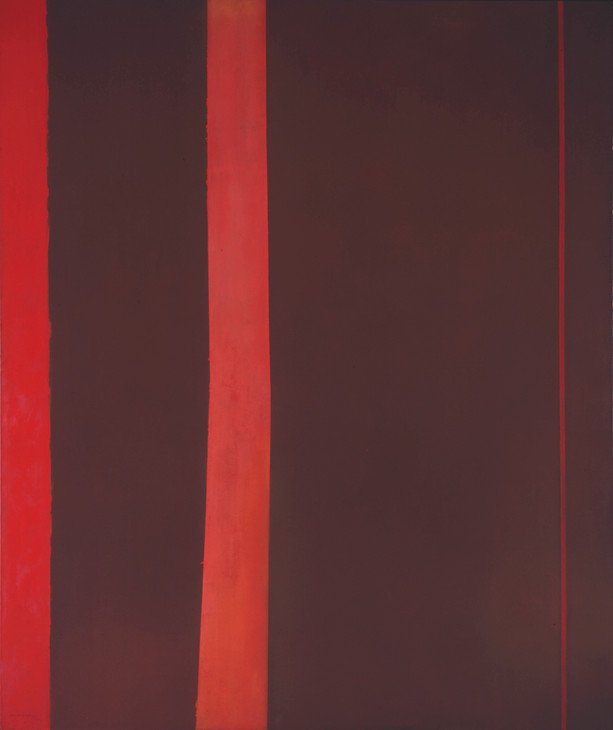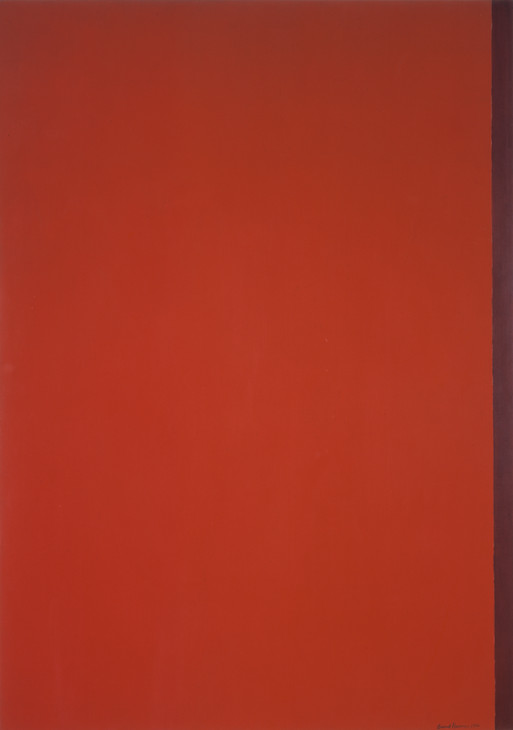Sublime Destruction: Barnett Newman’s Adam and Eve
Philip Shaw

Barnett Newman 1905–1970
Adam 1951–2
Oil on canvas
support: 2429 x 2029 mm
Tate T01091
Purchased 1968
© ARS, NY and DACS, London 2002
Fig.1
Barnett Newman
Adam 1951–2
Tate T01091
© ARS, NY and DACS, London 2002

Barnett Newman 1905–1970
Eve 1950
Oil on canvas
support: 2388 x 1721 x 50 mm
Tate T03081
Purchased 1980
© ARS, NY and DACS, London 2002
Fig.2
Barnett Newman
Eve 1950
Tate T03081
© ARS, NY and DACS, London 2002
In his landmark essay ‘The Sublime is Now’ (1948), the American abstract expressionist painter Barnett Newman announced that ‘the impulse of modern art’ resides in the ‘desire to destroy beauty’. The problem with beauty, according to Newman, is that it prevents the artist from realising ‘man’s desire for the exalted’, in other words, for the sublime. In religious art, for Newman in particular, a preoccupation with the beautiful – with its emphasis on the figurative, the perfection of form, and the ‘reality of sensation’ – has impeded the perception of ‘the Absolute’.1 Newman’s view accords here with that of the philosopher Immanuel Kant (1724–1804) who argued in his ‘Analytic of the Sublime’ (1790), from The Critique of Judgement, that the sublime, unlike the beautiful, ‘cannot be contained in any sensible form but concerns only ideas of reason’.2 The sublime, that is, is on the side of the mind rather than nature; and since the extent of the mind is unbounded it cannot be adequately represented by an object with determinate bounds.
Although Newman expresses reservations about Kant’s theory it is easy to see how frustration with the material limits of representation might be resolved through a commitment to abstraction. In Eve 1950 and Adam 1951–2 (Tate T03081 and T01091, figs.1 and 2) Newman makes no attempt to depict the first man and woman in any natural or literal sense. Instead of recognisable figures the viewer is presented with vast extents of red, interrupted by darker, vertical stripes. A thin, hard band of purple marks the outer right-hand edge of Eve, while Adam is divided by lighter, softer bands of cadmium to the far left, the left centre and a sharper, thinner stripe to the right. Yet although we have come a long way from the naturalism and idealism of Michelangelo’s Creation of Adam from the Sistine Chapel ceiling (1510), the titles of Newman’s paintings maintain a connection with the referential. The viewer, in other words, is encouraged to perceive the work before them as emblematic, in some way, of the divine.
It may be, as the art critic Arthur Danto suggests, that Newman was moved by the Old Testament injunction against the making of ‘graven images’ – a passage cited by Kant as ‘perhaps the most sublime ... in Jewish Law’ – and there is certainly a sense in which Newman’s refusal to depict sensible forms can be related to his Jewish background.3 Danto goes on to state that Newman’s painting is about something that can be said but not shown, ‘at least not pictorially’. Abstract painting, he concludes, is thus ‘not without content’.4
The sense of the work as a presentation of that which can be ‘said but not shown’ is enhanced by Newman’s insistence that viewers should place themselves close to the surfaces of his canvases so as to become enveloped or overwhelmed by a sense of boundlessness.
The sense of the work as a presentation of that which can be ‘said but not shown’ is enhanced by Newman’s insistence that viewers should place themselves close to the surfaces of his canvases so as to become enveloped or overwhelmed by a sense of boundlessness.
Above all, however, Newman’s painting is about the act of creation itself. And here again the works lend themselves to a religious interpretation. It is tempting, for example, to regard the vertical bands of colour as analogous to ‘an act of division, a gesture of separation, as God separated light from darkness, with a line drawn in the void’.5 As the artist’s friend and critic Thomas B. Hess notes, Newman himself claimed that the artist, like God, begins with chaos, the void.6 The artist’s first move is to re-enact God’s primal gesture by informing the void with a downward stroke or ‘zip’, created by laying a thin strip of masking tape over a freshly painted ground, which the artist then removes at the end of the painting process in a dramatic, revelatory instant. The zip has also been regarded as a representation of man, indeed, of the first man, Adam, ‘who walks upright ... virile, erect’.7 The name ‘Adam’, moreover, is derived from the Hebrew word adamah (earth), but is also linked with adom (red) and dam (blood).
Yet Newman, while fully aware of the religious cognates of his work, urges contemporary artists to free themselves from ‘the impediments of memory, association, nostalgia, legend [and] myth ... Instead of making cathedrals out of Christ, man, or “life”, we are’, he insists, ‘making it out of ourselves, out of our own feelings’.8 The ‘subject matter’ of Newman’s work is thus ‘creation itself’, an act associated no longer with God but with man. Ultimately, the terrifying or overwhelming aspects of Newman’s paintings become subordinated to the idea of sustaining the distinction between form and formlessness. As Newman stated, after visiting the sacred mounds of the Indians in south-west Ohio: ‘Looking at the site you feel, Here I am, here ... and out beyond there (beyond the limits of the site) there is chaos ... but here you get a sense of your own presence ... I became involved with making the viewer present: the idea that “Man is present”.’9
In recent years much has been made of Newman’s stress that ‘man is present’. He has been accused, variously, of a ‘fetishization of virility’ and of a politically regressive ‘exaltation of the individual’.10 Yet, as the cultural theorist Jean-François Lyotard has suggested, Newman’s affirmation of the individual is precariously conceived.11 In Eve, for example, the zip separating form and formlessness is located on the outer margins of the canvas; it barely registers as an act of creation. The fragile division between something and nothing, marked by the sudden disclosure of the zip is, above all, understood by Newman as a temporal event. In his 1949 Prologue for a New Aesthetic, the artist wrote that he was not interested with a ‘manipulation of space nor with the image, but with a sensation of time’.12 Lyotard adds that the conception of time presented in ‘The Sublime is Now’ has nothing to do with continuity or duration and as such is opposed to the constitution of the human subject. ‘Newman’s now’, writes Lyotard, ‘is a stranger to consciousness and cannot be constituted by it. Rather, it is what dismantles consciousness, what deposes consciousness, it is what consciousness cannot formulate, and even what consciousness forgets in order to constitute itself.’13 By way of Slavoj Zizek’s neo-Lacanian critique of the sublime, we might add that Newman’s now, materialized in the form of the zip, stands in for the impossible, inassimilable kernel of subjectivity. Far from aggrandising man, the creative act in Adam and Eve can thus be said to mark the degree zero, the bare minimum of difference necessary for the emergence of the human subject.
Notes
Barnett Newman, ‘The Sublime is Now’, in Barnett Newman: Selected Writings and Interviews, ed. John P. O’Neill (Berkeley and Los Angeles: University of California Press, 1992), pp. 170–3; passim.
Immanuel Kant, Critique of Judgement, trans. Walter S. Pluhar (Indiana: Hackett Publishing, 1987), p. 99.
Arthus C. Danto, Unnatural Wonders: Essays From the Gap Between Art and Life (New York: Columbia University Press, 2005), p. 192.
Serge Guilbaut, ‘Disdain for the Stain: Abstract Expressionism and Tachisme’ in Joan Marter (ed.), Abstract Expressionism: The International Context (Newbrunswick: Rutgers University Press, 2007), pp. 29-51; pp. 46–7.
Philip Shaw is Professor of Romantic Studies in the School of English at the University of Leicester and Co-Investigator of ‘The Sublime Object: Nature, Art and Language’.
How to cite
Philip Shaw, ‘Sublime Destruction: Barnett Newman’s Adam and Eve’, in Nigel Llewellyn and Christine Riding (eds.), The Art of the Sublime, Tate Research Publication, January 2013, https://www
